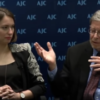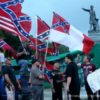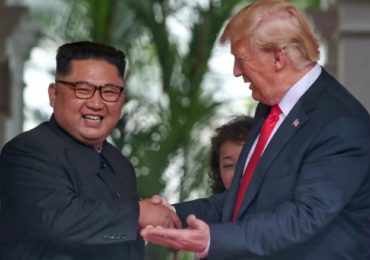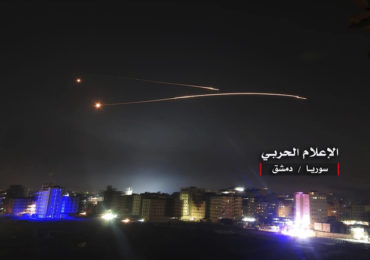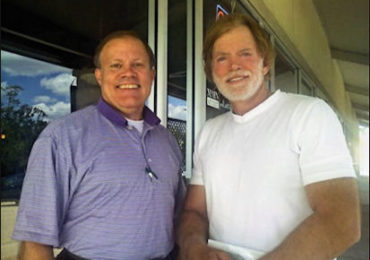From Zero Hedge
Liberty Blitzkrieg’s Mike Krieger notes that part of Trump’s appeal to many of his voters was, at least ostensibly, the idea that he would employ a less hawkish/neocon foreign policy than his opponent Hillary “We Came, We Saw, He Died” Clinton.
While it’s still too early to decisively say that Trump will usher in yet another foreign policy disaster for these United States and the world, it’s certainly not looking good.
The lobbing of tomahawk missiles into Syrian based on the fairytale that Assad launched a chemical weapons attack was the first sign that Trump is easily manipulated and impulsive. In fact, the episode bothered me so much I wrote a post detailing the dire ramifications titled, Prepare for Impact – This is the Beginning of the End for U.S. Empire. I suggest taking a read if you missed it the first time, it’s my most popular post of the year.
While that was bad enough, Trump’s cozying up to the barbaric, terrorist-supporitng leaders of Saudi Arabia has been by far the most concerning aspect of his foreign policy (if you can call it that) so far. This policy has become even more dangerous now that the 30-year old princeling who is leading the Saudis’ increasingly aggressive stance in the region has been named crown prince. It appears Trump is willing to let the Saudis do whatever they want in the region, which is guaranteed to have disastrous implications for America and the Middle East.
But a new Seymour Hersh article is out showing that the US knew there was no Assad chemical attack in April, but President Trump decided to bomb anyway.
And the details are shocking… as TheAntiMedia.org’s Darius Shahtahmasebi details, never one to accept the U.S. government’s official explanation of events without question, Pulitzer Prize-winning journalist Seymour Hersh has investigated Donald Trump’s decision to strike the al-Shayat Airbase in Syria in April of this year, which the president launched amid widespread allegations that the Syrian government committed a chemical weapons attack.
In a report entitled “Trump’s Red Line,” published Sunday in the daily German newspaper Die Welt, Hersh asserts that President Donald Trump ignored important intelligence reports when he made the decision to attack Syria after pictures emerged of dying children in the war-torn country.
For those of us without goldfish memories, Hersh’s recent investigation is reminiscent of his previous examination of the alleged chemical weapons attacks in 2013, detailed in an article entitled “Whose Sarin?” That article was published in the London Review of Books.
The official White House explanation for the events in April of this year was that Donald Trump was moved by the suffering of “beautiful” Syrian babies – the same Syrian babies he doesn’t want to set foot in the United States – and decided to punish the Syrian government for the attack two days after it allegedly occurred. This punishment came in the form of an airstrike despite the lack of a thorough investigation regarding what took place that fateful day in April and who was ultimately culpable (though the Trump administration insisted they were certain that Syrian President Bashar al-Assad was to blame).
In that context, it should come as no surprise that Trump acted rashly without consideration of the facts on the ground. However, what is most disturbing about Hersh’s account is the fact that, according to his source, Trump was well aware that the U.S. had no solid intelligence linking the Syrian government to a chemical weapons attack — and that’s because, according to Hersh’s article, it’s doubtful a chemical weapons attack occurred at all.
Hersh reports:
“The available intelligence made clear that the Syrians had targeted a jihadist meeting site on April 4 using a Russian-supplied guided bomb equipped with conventional explosives. Details of the attack, including information on its so-called high-value targets, had been provided by the Russians days in advance to American and allied military officials in Doha, whose mission is to coordinate all U.S., allied, Syrian and Russian Air Force operations in the region.”
“None of this makes any sense,” one officer reportedly told colleagues upon learning of the decision to bomb Syria, according to Hersh. “We KNOW that there was no chemical attack … the Russians are furious. Claiming we have the real intel and know the truth … I guess it didn’t matter whether we elected Clinton or Trump.”
According to Hersh, Trump “could not be swayed” by 48 hours worth of intense briefings and decision-making following the initial reports of the alleged chemical weapons attack. Hersh, who reportedly reviewed transcripts of real-time communications, explains that there is a “total disconnect” between the president and his military advisers and intelligence officials.
As is the case with Syrian military operations, Russia gave the U.S. details of the carefully planned attack on a meeting in Khan Sheikhoun, according to Hersh’s admittedly anonymous sources. The Russians had employed a drone to the area days before the attack to develop the intelligence necessary to coordinate it.
According to Hersh’s sources, the United States and its Russian counterpart routinely share information regarding planned attacks in order to avoid collisions. However, they also permit “coordination,” a practice that involves giving the other side a “hot tip about a command and control facility,” which then helps the other side carry out their attack.
Therefore, there was no surprise chemical weapons attack, as the Trump administration alleged. In fact, Russia had actually warned its American counterpart on the off-chance that there were any CIA assets on the ground who should have been forewarned of an impending attack.
“They [the Russians] were playing the game right,” a senior adviser told Hersh.
Hersh continues:
“Russian and Syrian intelligence officials, who coordinate operations closely with the American command posts, made it clear that the planned strike on Khan Sheikhoun was special because of the high-value target. ‘It was a red-hot change. The mission was out of the ordinary – scrub the sked,’ the senior adviser told me. ‘Every operations officer in the region’ – in the Army, Marine Corps, Air Force, CIA and NSA – ‘had to know there was something going on. The Russians gave the Syrian Air Force a guided bomb and that was a rarity. They’re skimpy with their guided bombs and rarely share them with the Syrian Air Force. And the Syrians assigned their best pilot to the mission, with the best wingman.’ The advance intelligence on the target, as supplied by the Russians, was given the highest possible score inside the American community.”
Hersh confirms Russia’s account of the incident, in which Russian authorities alleged that the Syrian Air Force bombed a “terrorist warehouse,” and that secondary bombings dispersed dangerous chemicals into the atmosphere.
Strangely, if Hersh’s reporting is accurate, it is not clear why Russia didn’t give the detailed account at the time — and why the Russians didn’t emphasize that they had shared information with the U.S. military well in advance of the attack, as this would have cast further doubt on the official U.S. narrative. In that context, Russia could have provided proof of any prior communications that took place within the so-called deconfliction channel. It also doesn’t explain why Russia’s president, Vladimir Putin, appeared to endorse two competing theories behind the events at Khan Sheikhoun.
However, Hersh continues:
“A team from Médecins Sans Frontières, treating victims from Khan Sheikhoun at a clinic 60 miles to the north, reported that ‘eight patients showed symptoms – including constricted pupils, muscle spasms and involuntary defecation – which are consistent with exposure to a neurotoxic agent such as sarin gas or similar compounds.’ MSF also visited other hospitals that had received victims and found that patients there ‘smelled of bleach, suggesting that they had been exposed to chlorine.’ In other words, evidence suggested that there was more than one chemical responsible for the symptoms observed, which would not have been the case if the Syrian Air Force – as opposition activists insisted – had dropped a sarin bomb, which has no percussive or ignition power to trigger secondary explosions. The range of symptoms is, however, consistent with the release of a mixture of chemicals, including chlorine and the organophosphates used in many fertilizers, which can cause neurotoxic effects similar to those of sarin.”
Hersh is not the first high-profile investigator to cast major doubts on the Trump administration’s official narrative regarding the events at Khan Sheikhoun. MIT professor emeritus Theodore Postol, who previously worked as a former scientific advisor to the U.S. military’s Chief of Naval Operations, poked major holes in the claims that the Syrian government had launched a chemical weapons attack at Khan Sheikhoun, noting the “politicization” of intelligence findings (you can access all of his reports here). Postol argued that there was no possible way U.S. government officials could have been sure Assad was behind the attack before they launched their strike, even though they claimed to be certain. Postol took the conversation even further, asserting that the available evidence pointed to an attack that was executed by individuals on the ground, not from an aircraft. Former weapons inspector Scott Ritter had similar concerns regarding the White House’s conclusions, as did former U.K. ambassador to Syria Peter Ford. The mainstream media paid almost zero attention to these reports, a slight that exposes the media’s complicity in allowing these acts of war to go ahead unquestioned.
“This was not a chemical weapons strike,” the adviser said. “That’s a fairy tale. If so, everyone involved in transferring, loading and arming the weapon – you’ve got to make it appear like a regular 500-pound conventional bomb – would be wearing Hazmat protective clothing in case of a leak. There would be very little chance of survival without such gear. Military grade sarin includes additives designed to increase toxicity and lethality. Every batch that comes out is maximized for death. That is why it is made. It is odorless and invisible and death can come within a minute. No cloud. Why produce a weapon that people can run away from?”
According to Hersh’s source, within hours of viewing the footage of the ‘attack’ and its aftermath, Trump ordered his national defense apparatus to plan for retaliation against the Syrian government. Hersh explains that despite the CIA and the DIA (Defense Intelligence Agency) having no evidence that Syria even had sarin, let alone that they used it on the battlefield, Trump was not easily persuaded once he had made up his mind.
“Everyone close to him knows his proclivity for acting precipitously when he does not know the facts,” the adviser told Hersh. “He doesn’t read anything and has no real historical knowledge. He wants verbal briefings and photographs. He’s a risk-taker. He can accept the consequences of a bad decision in the business world; he will just lose money. But in our world, lives will be lost and there will be long-term damage to our national security if he guesses wrong. He was told we did not have evidence of Syrian involvement and yet Trump says: ‘Do it.”’ [emphasis added]
At a meeting on April 6, 2017, at his Mar-a-Lago resort in Florida, Trump spoke with his national security officials regarding the best way to move forward. The meeting was not to decide what to do, Hersh explains, but how best to do it (and how to keep Trump as happy as possible).
Trump was given four options. The first one was dismissed at the outset because it involved doing nothing. The second one was the one that was decided upon: a minimal show of force (with advance warning to Russia). The third option was the strike package that Obama was unable to implement in 2013 in the face of mounting public opposition and Russia’s threats of intervention. This plan was Hillary Clinton’s ultimate fantasy considering she was encouraging it moments before Trump’s lone strike actually took place. However, this would have involved extensive air strikes on Assad’s airfields and would have drawn in the Russian military to a point of no return. The fourth option involved the direct assassination of the Syrian president by bombing his palaces, as well as his underground bunkers. This was not considered, either.
As we all witnessed in April, the second option was adopted, and the airbase Trump struck was up and running again in less than 24 hours, making it a very symbolic and empty show of force.
Hersh’s insight into the way Trump is conducting his foreign policy does not bode well for the future of the Syrian conflict (or anywhere else in the world, for that matter). Trump was not interested in the intelligence or the facts on the ground — if he had been, he would have waited until an investigation had determined culpability before ordering a strike.
Missing from Hersh’s account, however, is the fact that it was newly appointed national security advisor General H.R. McMaster who laid out the military strike proposals to the president at his resort on April 6. McMaster replaced former national security advisor Michael Flynn after the latter was forced to resign due to leaks from within the intelligence community. Due to Flynn’s alleged ties to Russia, it seems unlikely he would have proposed such a strike on Russia’s close ally to begin with.
It is unclear whether McMaster proposed the strikes in order to appease Trump or because McMaster ultimately wants Trump to adopt a tougher stance against Syria and Russia; McMaster has a history of pro-interventionism and anti-Russian sentiment.
Those commentators who can review these startling revelations but still condone Trump’s actions with a lazy ‘Assad is still a bad guy and must be overthrown’ mindset argument are being intellectually dishonest, with themselves and others. As was the case in 2013, there is still very little evidence that Assad has ever used chemical weapons — particularly in the attacks that the U.S. has tried to pin on him — yet this is the standard by which the corporate media and our respective governments have instructed us to judge Assad. Even without this conclusive evidence, shortly after the April events, U.S. ambassador to the U.N. Nikki Haley stated Assad will fall from power.
Hersh’s investigation bolsters many claims that the U.S. acted rashly without first conducting or ordering an impartial inquiry regarding what happened in April of this year. Hersh’s report also serves as a reminder to the world of the warpath we are continuing down, spearheaded by an impulsive and reckless megalomaniac who has no interest in ascertaining fact from fiction.
* * *
Liberty Blitzkrieg’s Mike Krieger also notes that just as interesting as the information above, is the fact that Hersh had to turn to a German newspaper to publish it. This makes perfect sense, because the one area where U.S. corporate press maintains unassailable consistency is when it comes to cheerleading for an interventionist, imperial foreign policy based on unverified claims and outright lies. Trump’s little fireworks display checked all those boxes, which is why the corporate media drooled all over the bombing, celebrating Trump for the first time of his Presidency. As Hersh notes:
After the meeting, with the Tomahawks on their way, Trump spoke to the nation from Mar-a-Lago, and accused Assad of using nerve gas to choke out “the lives of helpless men, women and children. It was a slow and brutal death for so many … No child of God should ever suffer such horror.”
The next few days were his most successful as president. America rallied around its commander in chief, as it always does in times of war.
Trump, who had campaigned as someone who advocated making peace with Assad, was bombing Syria 11 weeks after taking office, and was hailed for doing so by Republicans, Democrats and the media alike. One prominent TV anchorman, Brian Williams of MSNBC, used the word “beautiful” to describe the images of the Tomahawks being launched at sea. Speaking on CNN, Fareed Zakaria said: “I think Donald Trump became president of the United States.”
A review of the top 100 American newspapers showed that 39 of them published editorials supporting the bombing in its aftermath, including the New York Times, Washington Post and Wall Street Journal.
Which once again goes to show just how worthless, irresponsible and downright dangerous U.S. corporate media really is.
Finally, as Ron Paul rages below, Republicans cannot let go of “regime change” for Syria and new Cold War with Russia — even as the Democrats are starting to back away. Will the mainstream media stick with the narrative as well? Or is it all about to come crashing down?

